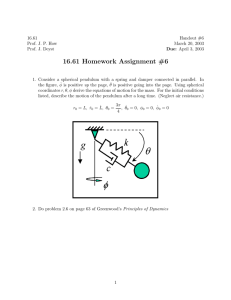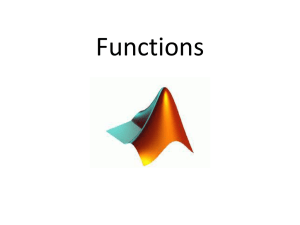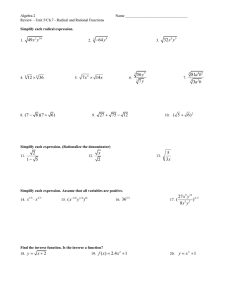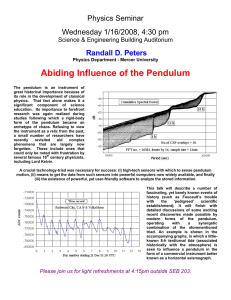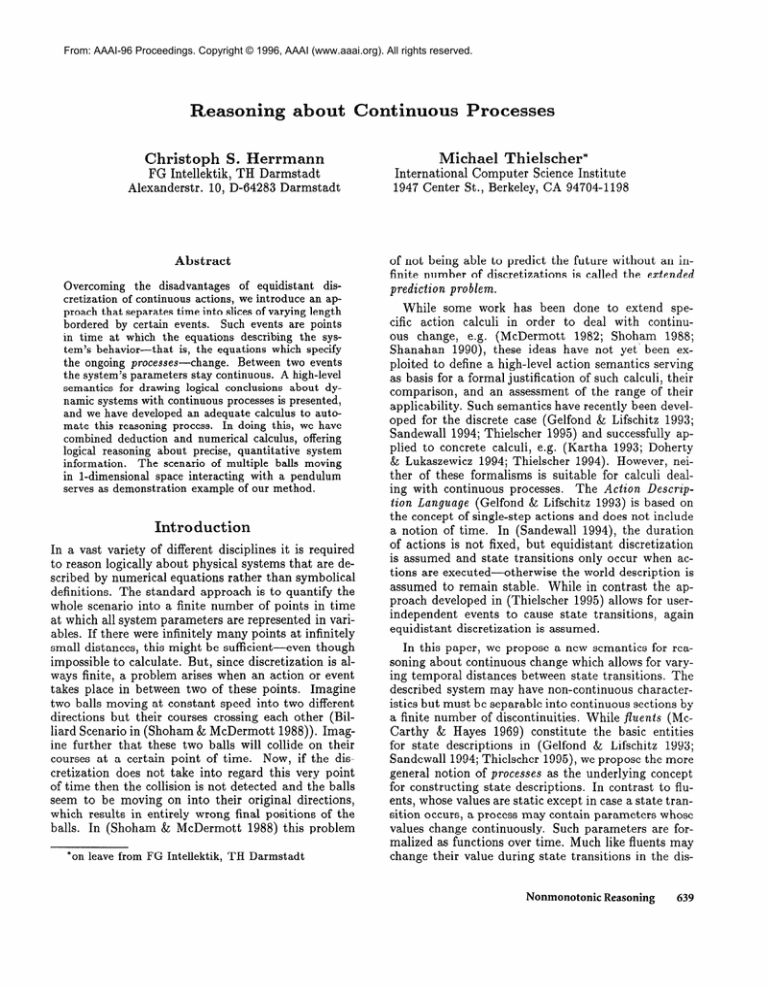
From: AAAI-96 Proceedings. Copyright © 1996, AAAI (www.aaai.org). All rights reserved.
Reasoning about Continuous
Christoph
Michael
S. IIerrmann
FG Intellektik,
TH Darmstadt
Alexanderstr.
10, D-64283 Darmstadt
Abstract
Overcoming the disadvantages of equidistant discretization of continuous actions, we introduce an approach that separates time into slices of varying length
bordered by certain events. Such events are points
in time at which the equations describing the system’s behavior-that
is, the equations which specify
the ongoing processes-change.
Between two events
the system’s parameters stay continuous. A high-level
semantics for drawing logical conclusions about dynamic systems with continuous processes is presented,
and we have developed an adequate calculus to automate this reasoning process. In doing this, we have
combined deduction and numerical calculus, offering
logical reasoning about precise, quantitative system
information.
The scenario
of multiple
balls moving
in l-dimensional space interacting with a pendulum
serves as demonstration example of our method.
Introduction
In a vast variety
to reason
logically
of different disciplines
about
scribed by numerical
physical
equations
systems
rather
it is required
that
are de-
than symbolical
definitions.
The standard
approach is to quantify the
whole scenario into a finite number of points in time
at which all system parameters
are represented in variables. If there were infinitely many points at infinitely
small distances, this might be sufficient-even
though
impossible to calculate.
But, since discretization
is always finite, a problem arises when an action or event
takes place in between two of these points.
Imagine
two balls moving at constant speed into two different
directions
but their courses crossing each other (Billiard Scenario in (Shoham & McDermott
1988)). Imagine further that these two balls will collide on their
courses at a certain point of time.
Now, if the discretization
does not take into regard this very point
of time then the collision is not detected and the balls
seem to be moving on into their original directions,
which results in entirely wrong final positions of the
balls. In (Shoham & McDermott
1988) this problem
*on leave from FG Intellektik, TH Darmstadt
International
1947 Center
Thielscher*
Computer
Science Institute
St., Berkeley, CA 94704-1198
of not being able to predict the future without an infinite number of discretizations
is called the extended
prediction
problem.
While some work has been done to extend specific action calculi in order to deal with continuous change,
e.g. (McDermott
1982; Shoham
1988;
Shanahan
1990), these ideas have not yet’ been exploited to define a high-level action semantics serving
as basis for a formal justification
of such calculi, their
and an assessment
of the range of their
comparison,
applicability.
Such semantics have recently been developed for the discrete case (Gelfond & Lifschitz 1993;
Sandewall 1994; Thielscher
1995) and successfully applied to concrete calculi, e.g. (Kartha
1993; Doherty
& Lukaszewicz 1994; Thielscher
1994). However, neither of these formalisms
is suitable for calculi dealing with continuous
processes.
The Action Description Languuge (Gelfond & Lifschitz 1993) is based on
the concept of single-step actions and does not include
a notion of time. In (Sandewall
1994), the duration
of actions is not fixed, but equidistant
discretization
is assumed and state transitions
only occur when actions are executed-otherwise
the world description
is
assumed to remain stable.
While in contrast the approach developed in (Thielscher
1995) allows for userindependent
events to cause state transitions,
again
equidistant
discretization
is assumed.
In this paper, we propose a new semantics for reasoning about continuous change which allows for varying temporal distances between state transitions.
The
described system may have non-continuous
characteristics but must be separable into continuous sections by
a finite number of discontinuities.
While jluents (McCarthy & Hayes 1969) constitute
the basic entities
for state descriptions
in (Gelfond & Lifschitz 1993;
Sandewall 1994; Thielscher 1995), we propose the more
general notion of processes as the underlying
concept
for constructing
state descriptions.
In contrast to fluents, whose values are static except in case a state transition occurs, a process may contain parameters
whose
values change continuously.
Such parameters
are formalized as functions over time. Much like fluents may
change their value during state transitions
in the dis-
Nonmonotonic Reasoning
639
Crete case, in the continuous
case a state transition
may cause existing processes to disappear
and new
processes to arise. State transitions
are either triggered by the execution
of actions (so-called external
events, e.g., hitting an idling ball) or by interactions
between processes (so-called internal events, e.g., collisions of moving balls).
Both external
and internal
events are specified by transition laws.
On this basis, we have developed a formal, modeltheoretic
semantics
for reasoning
about domains involving continuous
change.
An application
example
will be used to illustrate
the formalism.
We moreover have developed an adequate (wrt. our semantics)
extension
of an action calculus using logic programming based on an approach developed in (Hiilldobler
& Schneeberger
1990). Due to lack of space, a description had to be omitted; it can be found in (Herrmann
& Thielscher 1996). At the end of this paper, the interested reader may in addition find an internet address
of our calculus.
for a PROLOG implementation
A Logic of Processes
In this section, we introduce
a formal semantics
for
reasoning about continuous processes, their interaction
in the course of time, and their manipulation
by means
of executing actions.
Processes
While fluents form the basic components
of situation
descriptions
in classical, discrete approaches
like situation calculus (McCarthy
& Hayes 1969), we use a
generalized
notion called processes as the basic entities of situation descriptions
in our model of continuous
change. Any concrete process is an instance of a general type of processes, like “continuous
movement of a
physical object in a l-dimensional
space.” The type
a process belongs to determines
its description
components.
More precisely, each type is associated with
a so-called scheme specifying two kinds of parameters:
the static parameters,
which do not change as long as
the process is in progress (like the coordinates
of the
starting
point or the velocity of a continuously
movwhose actual
ing object), and the dynamic parameters,
values are time-dependent
and are therefore subject to
change in the course of the process (like the actual location of a moving object). Components
of the dynamic
description
part are formally represented
as functions
whose arguments
are the static parameters
plus two
time-points,
namely, the starting
time of the process
and the actual time:
Definition
1
A process scheme is a pair (C, F)
where
C is a finite,
ordered
set of symbols
of
F is a finite set of functions
size n > 0 and
f :lFP+=l-+JFL
For example,
cess scheme
l-dimensional
640
the two components
describing
continuous
space are as follows:
Knowledge Representation
(C, F) of a promovement
in a
C = { 20, ?) and
, where ~0 denotes
F = (~(20, i, to, t) = xo+i(t-to)}
the starting coordinate;
i the velocity; to and t the
starting and the actual time, respectively,
of the process; and x denotes the actual location of the moving
object at time t .
Any process is an instance of some process scheme
and referred to by a (unique) name:
Definition
2
Let N be a set of symbols (called
names). A process is a 4-tuple
(n, 7, to, J?) where
0 nEN;
a 7 = (C, F)
C is of size
a to E IR (the
63 g= (PI,...
over IR (the
is a process
scheme
(the type), where
n ;
starting
,pn)
time);
and
E lR,” is an n-dimensional
parameter
For example, let
from above then’
7 move
denote
the example
(TrainA, Zkve , 1:OOpm, (Omi, 25mph) )
(Train-B,
vector
vector)
Tmove, 1:30pm,
(80mi, -2Omph) )
scheme
(1)
are two processes describing two trains starting at different times and, then, moving towards each other,
with different speed.2
Based on these notions, we call a set S of processes
in conjunction
with a particular
time-point
ts E IR a
situation.
Value ts denotes the time when S arose.
We assume that two distinct
processes occurring
in
the same situation have different names, chosen from a
given set. If neither an interaction
between the given
processes nor actions take place then the individual
processes are assumed to continue eternally.
In this
case, S provides a description
of the system being
modeled at any time t 2 ts .
Events
and Transition
Laws
However, even without manipulating
the ongoing processes by means of executing
actions, processes may
interact and, by doing this, destroy the harmony.
In
such cases, a situation
(S, ts) is only a time-limited
description,
whose suitability
ends as soon as interaction gives rise to changes within the collection of processes. Such a breakpoint,
which causes a discontinuity
in the state of affairs, is called event. In general, an
event causes some running processes to end and some
new processes to start at a particular
point in time.
For instance,
an inelastic collision between two moving objects terminates,
at the time they meet, both
movements and initiates two new processes where both
objects move side-by-side,
possibly in a new direction
and with changed velocity.
‘The following example was inspired by (Shoham & McDermott 1988).
2The starting location of the first train, TrainA, is
taken as reference point of the l-dimensional coordinate
system; hence, the initial distance between the two trains
is 80 miles.
Generally, any non-trivial
situ .ation (S, i?~) gives rise
to a variety of potential events at various time-points
t > ts . Whether such an event actually occurs depends on whether the situation remains stable until the
expected occurrence of the event. It is therefore crucial
to find the very next event; only this one is guaranteed
To illustrate
this point, which
to occur as expected.
we call the nearest event problem, consider the situation displayed in Figure 1. While an analysis of the
movements of Balls A and B results in the expectation
that they collide, an analysis of A and C shows that
prior to this we have to check whether these two balls
collide first. If this is indeed the case then we should
compute the effect of that discontinuity
first and see
whether Balls A and B still move towards each other.
event ‘s time is usually determined
by the instances of
For example, the transition
law for
other variables.
inelastic collisions of two continuously
moving objects
in a I-dimensional
space is as follows (variables
are
denoted by uppercase letters):
(C
=
{
t
=
T,
E
=
{
(NA,
%ove,
TAO,
(XAO
(NB,
znwe,
TBO,
(-GO,
(NA,
Zmv,,
T,
(h,
Zmw, 57,(-%w,
, 2A))
,
%3))
} ,
(3)
(-%ew,
2A
+
&))
,
*A
+
2~))
}
)
where it is required
NA # NB , XA - XB # 0 ,
and xNA = xNg = Xnew at time T.
In our
example,
where the two movement
differentials
are
x(XAO,~A,TAO,T)
=
XAO
+
~A(T
-
TAO)
and
XBO f XB(T - TBc) , this leads
x(XBO,*B,TBO,T)=
to:
T
and
Figure 1: To predict the courses of the balls it is crucial
to determine the nearest event. In case of any collision,
will A and C collide first, or A and B?
This is reflected
in the following
definition:
An event is a triple (C, t, E) where
Definition 3
C (the condition)
and E (the enect) are (possibly
empty) finite sets of processes and t E R is the time
at which the event is expected to occur.
Let (S, ts) be a situation then an event (C, t, E) is
potentially applicable iff C C S and t > ts . If I is a
set of events then some (C, t, E) E C is applicable to
(S, ts) wrt. & iff it is potentially
applicable
and for
each potentially
applicable
(C’, t’, E’) E I we have
t 2 t’.
While in general more than just one actually applicable event may exist, we will restrict ourselves to nonsimultaneity
in this first approach.
As an example,
let S denote the two processes defined in (1) and let
ts = 1:30pm then the following event-describing
an
inelastic collision3-is
applicable
to (S, ts) provided
no other event occurs in between:
( C
= { (TrainA,
I,,,,,
l:OOpm, (Omi, 25mph)),
(TrainB,
7,,,,,
1:30pm, (80mi, -2Omph))
t
= 3:00pm,
E
= { (TrainA,
(TrainB)
} ,
(2)
lmove, 3:00pm, (SOmi, 5mph)),
Love, 3:00pm, (SOmi, Smph)) }
Concrete events are instances
of general transition
laws, which contain variables and, possibly, constraints
to guide the process of instantiation.
In particular
the
3This collision is to be interpreted as a coupling of trains
rather than a violent crash.
X,,,
=
X~-XR~;~~~~+&T~~
(4)
= XAO +*A&-TAO)
Note that in case the two objects do not head towards each other, this equation
will result in some
that is, the corresponding
event can
T < TAO,TBO;
never be (potentially)
applicable
to a situation
with
time Ts > TAO, TBO . The reader is invited to verify
that (2) isindeed
a valid instance of (3).
On the basis of a set of events (i.e., the collection of
all ground instances of given transition
laws), the behavior of the model, starting in a particular initial situation, can be described by repeatedly searching for aPplicable events and, then, calculating
their impact. As
indicated,
we restrict our model to-non-simultaneous
events, which is reflected in the following definition:
Definition
4
Let E be a set of events and (S, ts)
a situation
then the successor situation Q((S, ts)) is
defined as follows:
I. ;fSno yplicable
e
event exists in I then
2. If’&)
E 8 is the only applicable
@a((,!?,ts)) = (S’, tp) where
@ S’ = (S\C)UE
Q((S, ts)) =
event
then
ts/ =t
3. Otherwise
(a((,!?, ts))
is undefined.
In words, if no applicable event exists then the system
has reached a stable state, which is assumed to hold
forever; else the result of an applicable
event is obtained by exchanging processes according to the event’s
description
and adjusting
the initiating
time-point
of
the new situation
accordingly.
The former represents
the assumption
of persistence:
Each process which is
not affected by the event continues to run in the new
situation just like it did in the preceding one. In what
follows, we implicitly assume Q be always defined.
The repeated
application
of the successor situation function yields an infinite sequence of situations,
Nonmonotonic Reasoning
641
(Sdo) ,
@((SO,~O)),
@2((S&)),
....
Then
the
state of the system at a particular
time-point
t 2 to
is correctly
described
by the collection
of processes
and
(S’,tp)
=
S where
(S, ts)
= @‘((So, to))
@+‘((So, to))
such that ts 5 t < tst , for some
L 2 0 . For example,
starting
with ((l), 1:3Opm) ,
the locations of the two trains, say, are determined
by (1) until 3:00pm, while after the collision the new
processes,
E in (2), have to be used instead.
The above concept supports the notion of truth and
of
falsity of observations made during a development
the system being modeled. Formally, an observation
is
an expression of the form [t] a(n) = r where
e
t
E R
In words, the process describing TrainB
idle at locawill be replaced by the process describing the train’s movement with velocity & = -20mph.
As before, such events may be instances of more gention x0 = 80mi
eral transition
(C
=
{ (Train4
t
=
T,
E
=
{ (Train-4
is the time of the observation;
(Train4
o o! is either a symbol in C or the name of a function
in F for some process scheme (C, F) ;
e n is a symbol
denoting
e r E IR is the observed
a process
name;
value.
C = {cl,.
2. or C.Y.
E F and
..,ck: = CY,.. .,cn}
a(~,
and
rk = r;
The concept of agents executing actions in a system of
continuous
processes can be easily integrated
into our
model by viewing actions as (artificial) events as well.
For example, the following event describes the action
TrainB
( C =
{ (TrainB,
t
=
1:30pm 7
E
=
{ (TrainB,
at time 1:30pm:
I,,,,,
l:OOpm, (80mi, Omph)) } ,
I,,,,,
1:30pm, (80mi, -2Omph))
Knowledge Representation
(XAO,
AA))
(-GO,
,
Omph))
1,
Gove,
Gove,
TA , ( XAO
, AA))
T,
-2Omph))
(XBO,
,
}
)
is not changed in (6).
considered
in the previous subsection
concerning
successor
and, then, all def-
situations,
developments,
remain as they are.
Pendulum
and
ails Scenario
In this section, we illustrate
how a more complex domain, namely, the interaction
between a pendulum
and balls that travel along a l-dimensional
space, can
be modeled on the basis of our formalism.
Figure 2
shows the pendulum
which will collide at angle cp = 0
with a ball being at position
y = yc at the same
time. Since the logic part of the formalization
is essentially domain-independent,
the task left is to find
appropriate
equations
describing the various possible
movements (that is, defining process schemes) and the
possible interactions (that is, defining transition laws).
For simplicity, we will neglect the damping factor of
the motion of the nendulum. The differential equation
it then ;s
m
12
d2Q
-p-=
-mgl
sin Q -
I2dQ
dt
where I is the length of the pendulum,
m is the mass
of the pendulum,
and g is 9.812 . Solving the differential results in the angle of the pendulum
cp , the
angular velocity + and the angular acceleration
$ .5
(5)
) )
4We have E(ZO = 80mi, i = -2Omph, to = 1:30pm, t =
2:lSpm) = 80mi - 20mph(2:15pm - 1:3Opm) = 65mi.
642
7kve, TAO,
5’iiove,TB,
Given a set of events representing
actions that are
to be executed, these are added to the ‘natural’ events
describing
Actions
of starting
Train4
and observations
E.g., observation
[2:15pm]x(TrainB)
= 65mi is true
in our example according
to (1)4 while observation
[3: 15pm]x(TrainB)
= 45mi, say, is not since the latter
does not take into account the train collision.
On this basis, we can define temporal projection
as
well as postdiction
problems (called chronicle completion in (Sandewall 1994)) in the standard way (Gelfond
& Lifschitz 1993; Sandewall
1994; Thielscher
1995)
using model-theoretic
concepts:
A model for a set
of observations
g (under given sets of names
N
I 2 is a system
and events
development
(So, to) ,
@((SO, to)) , @ ((SO, to)) , . . . which satisfies all elements of !P a Such a set Q entaib an (additional)
observation
$ iff G is true in all models of Q .
by
where it is required in # 0 and XAO+~A(T-TAO)
=
12.5mi. E.g., given the first process in (1) along with
(Train-b
Ti,ove, l:OOpm, (80mi, Omph)) , the event described
in (5) is essentially
an instance
of (6)considering
the fact that
the process
describing
initions
. . . , rla,to, t) = r .
is triggered
(6)
(Train-B,
and
Given an initial situation
along with a set of events,
such an observation
is true iff the following holds: Let
S be the collection of processes describing
the system at time t (determined
as discussed above) then
S contains a process (n, (C, F), to, (rl, . . . , m)) such
that
1. either
laws whose applicability
the intention to execute some action. A most interesting feature of this representation
of actions is that the
time of their execution may depend on the situation
itself. For instance, the specification
“Start the idling
TrainB
to move with velocity
-20mph
as soon as
TrainA
passes the 12.5mi mark.” can be represented
by this transition
law:
Q(Q maxy
77 TPO
3 T)
=
-Qmax
COS( -“,”
(T
-
TPO))
5For the sake of simplicity, we will regard the time constant 7 of the pendulum be given rather than its length I
(we have r =
where it is required
4(
1
that
“;I&
YAc # 0 , r # 0 ,
+
5
TAO
-
Go)
7-
and
T
=
ycyyAQ +TAO
yA
7.
Figure 2: Pendulum
P and
‘pp = -prnaz
and YA = 0.
d(Q
+tQ
max,
T’,TPO, T)
=
2x
Qmax
A
Ball
;
sin( 2?r
r
47r2
rnax,f,T~~tT)
=
Qmax
-
COS(7
72
in positions
(‘I’-TPO))
2R (T -
TPO))
(7)
irpendulum, 0, (10, 1, 0.3))
For a ball moving along the y-axis, we use a process scheme
‘&move = (C, F) similar
to the one
used in the preceding section, viz. C = {yc, jl} and
F = {Y(Yo, jl,to,t> = Yo + jl(t - to)) *
Based on the two process schemes, we define three
different types of events. The first is the collision of two
balls, A and B, defined by identical locations at some
time
t , that
is,
Y(Y~o,cA,tAo,t)
=
C
=
t
=
E
=
{
(JVA,;Tmove,TAo,(YAO,~AO))
9
( NP,
7, Yc>> ) ,
qendulum
9 TPO 3 (Qmaz,
(8)
TiNA, lmove, T, (YC, -%4o)) ,
(NP,irpendulum,T~~,(Qmax,r,Y~)))
6A second-p endulum is in its
point of time (t - tp0)
= vsec
Q
‘&move, 2, (0,0.4))}
)
Now, given the initial situation
({(i’)}, Osec) , the
above event designs a successor state at time t = 2sec
by adding the moving ball. Following this state transition, the transition
law (8) will be fulfilled for time
t = 2.75sec as the nearest event (see previous section),
since
t =
1
2
yciIa
4( ~‘~~~-fe~
+ t&I =
:SeC + 2sec
+2sec-lsec)
lsec
=
+1
and
4 ElN
>
This results in the pendulum
moving unaltered
while
the ball now moves into the opposite direction,
that
is, we obtain (BallA, TmOve,2.75, (0.3, -0.4))
as a new
process. With our approach, we can query for the occurrence of such discontinuities
and detect further collisions after this nearest event. Also, we can insert new
balls at arbitrary
time and location or stop and start
the pendulum
with variable velocity.
Y(Y~o,tiB,tBo,t),
similar to equations (4).
The second type of event is the collision between
any ball and the pendulum,
defined by the angle of
the pendulum
being zero while the ball’s position is
at the y-axis position of the pendulum,
yc , at the
same time. Since in real physical systems, after such a
collision ball and pendulum
would move chaotically in
3-dimensional
space, we introduce an arbitrary simplification for the sake of a deterministic
behavior.
The
pendulum
is assumed to be fixed in its y-axis and to
be of much larger mass than the ball, such that the
collision will simply be an elastic impact with a stillstanding
object for the ball (reflection
into opposite
direction)
while the pendulum
keeps moving continuously. This results in the following transition
law:
(
t = ‘Lsec, E = {(BallA,
W={L
As the process scheme for the pendulum
we obtain
7 pendulum = (C, F) where C = {cpm,, , 7, yc} and
E.g., if we start a pendulum
with
F = {cp, d, 91.
7 = lsec
suspension
point yc = 0.3771, time constant
(such a pendulum
is often called second-pendubum6)
and starting
angle lo,,,
= 10’ at time tpo = Osec
then the corresponding
process becomes
(Pendul~P,
That is, the pendulum process remains unchanged and
new parameters
result for the ball. As above, if no
collision will occur we obtain a value T smaller than
the actual time.
The last type of event is simply user interaction
like
inserting
a new ball into the scenario or starting the
pendulum.
E.g., the following event formalizes our intention to start a ball from position
yc = Om at time
t = 2sec to move with speed $ = 0.4m/sec :
>
= 0 position at every
(n E JN) .
Discussion
Generalizing
the concept of state descriptions
as collections of fluents, our approach of process separation
introduces
a syntax and semantics
to formalize and
reason about descriptions
of continuous
physical systems. In addition,
in (Herrmann
& Thielscher
1996)
we offer a suitable calculus that is based on logic programming and allows for logical reasoning in terms of
meaningful
expressions (e.g. collision event) as well as
precise numerical
values about the processes (e.g. location at a certain time). Hence, a process separation
model of a real world system can serve to evaluate the
proper behavior of a system that may be specified by
differential equations in our calculus.
While purely numerical approaches do not allow logical reasoning about system phenomena,
the so-called
Qualitative Reasoning uses qualitative
descriptions
to
model a system and offers a logic based on descriptive attributes
(Kuipers
1994). Applications
of this
method model physical systems in qualitative simudations (Faltings
& Struss 1992). A reproach of Qualitative Reasoning is the absence of quantitative
values.
Nonmonotonic Reasoning
643
Our process separation model allows to reason logically
about predefined events and is still based on precise
numerical values accessible to the user.
We have been able to solve the extended prediction
problem
by limiting the number of future time slices in
concentrating
on ‘interesting’ points in time, that is,
where events occur. Since we take all possible events
at which the system is assumed to change its parameters into account, this quantization
avoids the false predictions mentioned
in (Shoham & McDermott
1988).
Our approach is not limited to a previously fixed number of objects in our scenarios, since we allow actions
that may start new objects to participate
in our system model.
Also, the occurrence
of potential
events
or their amount need not be known in advance.
It is
just necessary to specify the conditions under which an
event occurs and the new parameters
that result from
such an event, in form of transition daws.
A previous approach to temporal
reasoning
about
continuous
systems has introduced
manifested
histories vs. potentiuE histories (Shoham 1988). In that approach the potential future courses of two balls may be
altered if a collision manifests different courses which
only works for discrete points of time as the author
admits in his “Technical Limitations.”
In our calculus,
time is real-valued
and not affected by this problem.
Another way to reason about physical systems using differential
equations
and temporal
logic was introduced in (Sandewall
1989). Discontinuous
systems
were divided into piecewise continuous
ones separated
by discontinuities.
As argued in (Allen 1984), such a
representation
in the form of time-points
rather than
intervals bears the problem of not being able to correctly model the change of multiple parameters
in one
time-point.
We overcome this problem by separating
the system into multiple processes, where all parameters can be adjusted for a new interval of time.
Finally, let us recall the restriction
that the current versions of our semantics and calculus do not allow events to occur simultaneously.
In case two or
more events occur at the same time but without mutual influence,
this could be straightforwardly
modeled. But if two or more simultaneous
events concern
identical objects (e.g., three balls all moving towards a
single collision) then the overall result might not simply be the combination
of the results of the involved
events. Rather, such situations
require more sophisticated means to construct suitable state transition
functions. Recent solutions to this problem for the discrete
case, e.g. (Lin & Shoham 1992; Baral & Gelfond 1993;
Thielscher
1995), will help to establish
an adequate
extension
of our formalism;
yet, this is left as future
work.
Internet
Availability.
we have provided
PROLOG
For the interested
reader,
sources on our ftp-server
aida.intellektik.informatik.th-darmstadt.de
in the directory
644
/pub/AIDA/ContProc.
Knowledge Representation
Allen, J. F. 1984. Towards a General
and Time. Artif, Intell. 23:123-154.
Theory
of Action
Baral, C., and Gelfond, M. 1993. Representing
concurrent
actions in extended logic programming.
In Bajcsy, R., ed.,
Proc. of IJCAI,
866-871.
Chambery,
France.
Doherty, P., and Lukaszewicz,
W. 1994. Circumscribing
features and fluents. In Gabbay, D., and Ohlbach, H. J.,
eds., Proc. of the Int. ‘1 Conf. on Temporal Logic (ICTL),
vol. 827 of LNAI, 82-100.
Springer.
Faltings,
B., and Struss,
MIT
Qualitative Physics.
P. 1992.
Press.
Gelfond, M., and Lifschitz, V.
and change by logic programs.
17:301-321.
Recent
Advances
in
1993. Representing
action
J. of Logic Programming
Herrmann, C. S., and Thielscher,
M. 1996. On Reasoning
About Continuous
Processes.
Technical
Report
AIDA96-04, FG Intellektik,
TH Darmstadt.
Holldobler,
S., and Schneeberger,
J. 1990. A new deductive approach
to planning.
New Generation
Computing
8~225-244.
Kartha, G. N. 1993. Soundness
and completeness
theorems for three formalizations
of actions.
In Bajcsy, R.,
ed., Proc. of IJCAI,
724-729.
ChambCry, France.
Kuipers,
B. 1994.
Qualitative
reasoning:
modeling
MIT Press.
simulation
with incomplete
knowledge.
and
Lin, F., and Shoham, Y. 1992. Concurrent
actions in the
situation calculus.
In Proc. of AAAI, 590-595.
San Jose,
CA: MIT Press.
McCarthy,
J., and Hayes, P. 9.
cal problems from the standpoint
Machine
Intell. 4:463-502.
1969. Some philosophiof artificial intelligence.
McDermott,
D.
1982.
A temporal
logic for reasoning
about processes and plans. J. of Cog. Sci. 6:101-155.
Sandewall, E. 1989. Combining logic and differential equations for describing
real-world
systems.
In Brachman,
R.; Levesque,
H. J.; and Reiter, R., eds., Proc. of the
Int. ‘1 Conf. on Principles
of Knowledge
Representation
and Reasoning.
Toronto,
Kanada:
Morgan Kaufmann.
Sandewall,
E.
versity Press.
1994.
Features
and Fluents.
Oxford
Uni-
Shanahan,
M. P. 1990. Representing
continuous
in the event calculus.
In Proc. of ECAI, 598-603.
change
Shoham, Y., and McDermott,
D. 1988. Problems
mal temporal reasoning.
Artif. Intell. 36:49-61.
in for-
Shoham,
Y.
1988.
ments in nonmonotonic
36:279-331.
Chronological
ignorance:
Experitemporal reasoning.
Artif, Intell.
Thielscher,
M. 1994. Representing
actions in equational
logic programming.
In Hentenryck,
P. V., ed., Proc. of
the Int. ‘I Conf. on Logic Programming,
207-224.
Santa
Margherita
Ligure, Italy: MIT Press.
Thielscher,
M. 1995. The logic of dynamic
systems.
In
Mellish, C. S., ed., Proc. of IJCAI,
1956-1962.
Montreal,
Canada.


